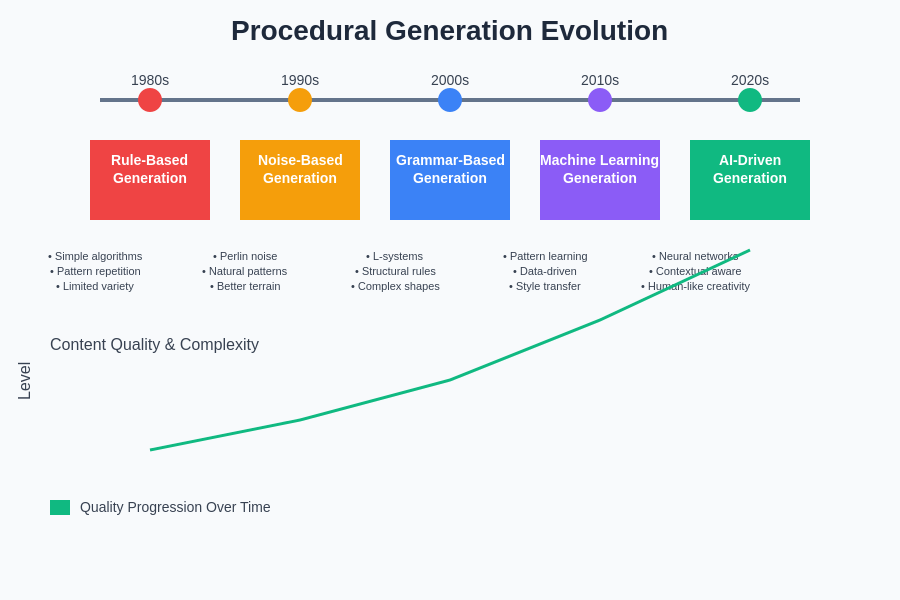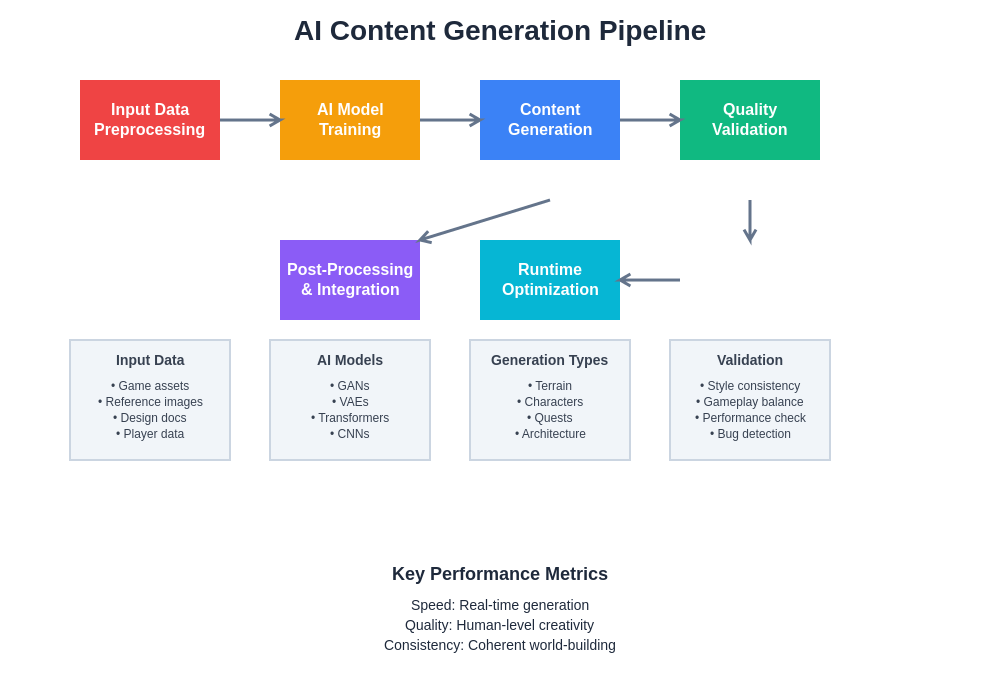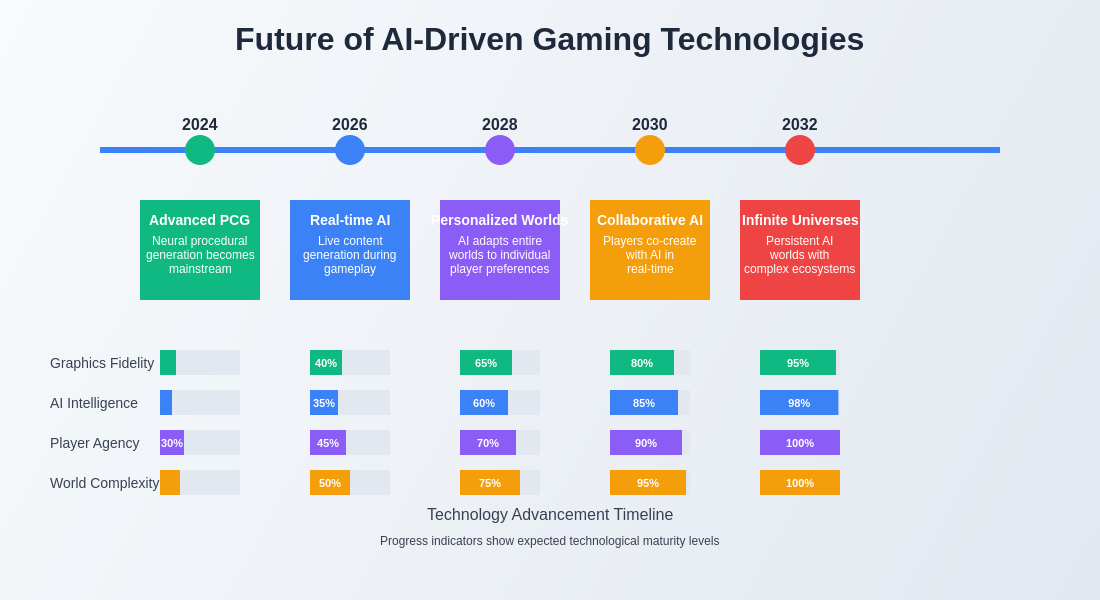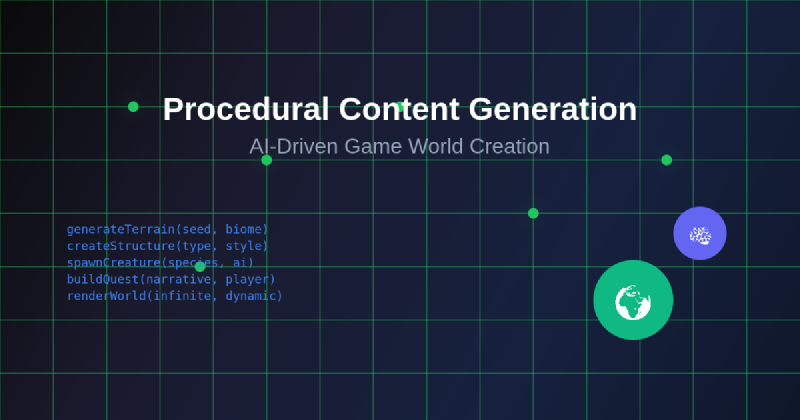The gaming industry stands at the precipice of a revolutionary transformation where artificial intelligence meets creative world-building, giving birth to procedural content generation systems that can create vast, intricate, and dynamically evolving game worlds. This technological convergence represents far more than a mere advancement in game development tools; it embodies a fundamental shift in how interactive entertainment is conceived, designed, and experienced by players worldwide.
Discover the latest AI trends in gaming to stay informed about cutting-edge developments that are reshaping the interactive entertainment landscape. The integration of artificial intelligence into procedural content generation has opened unprecedented possibilities for creating gaming experiences that are not only vast in scope but also deeply personalized and infinitely replayable, challenging traditional notions of what constitutes a complete gaming experience.
The Evolution of Procedural Generation in Gaming
The concept of procedural content generation has deep roots in gaming history, dating back to early titles that used algorithmic approaches to create game content due to hardware limitations and storage constraints. However, the integration of modern artificial intelligence techniques has elevated procedural generation from a practical necessity to a creative powerhouse capable of producing content that rivals or even surpasses human-crafted game elements in complexity and engagement.
Traditional procedural generation relied heavily on mathematical algorithms and random number generation to create content, often resulting in repetitive patterns and limited variation that experienced players could easily recognize and predict. Modern AI-driven procedural generation systems leverage machine learning algorithms, neural networks, and sophisticated pattern recognition to create content that exhibits genuine creativity, contextual awareness, and adaptive complexity that responds to player behavior and preferences.
The transformation from rule-based procedural generation to AI-driven content creation represents a quantum leap in the sophistication and quality of generated content. Where traditional systems might generate terrain based on simple noise functions and predefined rules, AI-driven systems can analyze thousands of hand-crafted game environments, learn the principles that make them engaging, and apply those insights to generate new content that maintains the artistic vision and gameplay balance that human designers intended.

The evolution of procedural generation techniques demonstrates a clear progression from simple rule-based systems to sophisticated AI-driven approaches that can understand and replicate complex design patterns. This technological advancement has fundamentally changed the landscape of game development, enabling creators to achieve previously impossible scales of content generation while maintaining artistic quality and gameplay coherence.
Terrain and Environment Generation
One of the most visually striking applications of AI-driven procedural content generation lies in the creation of realistic and diverse terrain systems that form the foundation of immersive game worlds. Modern AI systems can analyze geological data, satellite imagery, and artistic references to generate terrain that not only looks realistic but also serves specific gameplay purposes and maintains internal consistency across vast virtual landscapes.
These advanced terrain generation systems go beyond simple height mapping and noise-based approaches by incorporating understanding of geological processes, climate patterns, and ecological relationships. AI algorithms can generate mountain ranges that follow realistic geological formation principles, river systems that carve believable paths through landscapes, and vegetation patterns that respond appropriately to elevation, climate, and soil conditions.
Experience advanced AI capabilities with Claude for game development projects that require sophisticated procedural generation and creative problem-solving. The integration of AI into terrain generation has enabled the creation of game worlds that feel lived-in and authentic, with every element contributing to a cohesive environmental narrative that enhances player immersion and engagement.
The sophistication of modern AI-driven terrain generation extends to the creation of multiple biome systems that transition naturally between different environmental zones. These systems can generate arctic tundra that gradually transitions into temperate forests, which then give way to arid deserts, all while maintaining logical geographical relationships and creating opportunities for diverse gameplay experiences within a single, cohesive world.
Architecture and Structure Generation
The application of artificial intelligence to architectural and structural generation has opened new frontiers in creating believable urban environments, ancient ruins, and futuristic cities that serve both aesthetic and functional purposes within game worlds. AI systems trained on architectural principles, historical building styles, and urban planning concepts can generate structures that feel authentic while serving specific gameplay requirements and narrative purposes.
Modern AI-driven architectural generation goes beyond simple building placement by understanding the relationships between different types of structures, the flow of pedestrian and vehicle traffic, and the cultural and historical contexts that influence architectural styles. These systems can generate medieval villages with appropriate defensive considerations, modern cities with logical infrastructure networks, and alien settlements that maintain internal consistency while appearing genuinely otherworldly.
The sophistication of AI-driven architectural generation extends to interior spaces, where algorithms can create complex building layouts that balance navigational clarity with environmental storytelling. These systems understand the purposes of different room types, the logical flow between spaces, and the placement of objects and furniture that creates believable lived-in environments while maintaining optimal gameplay flow and player orientation.
AI-generated architectural systems can also adapt their output based on the intended gameplay experience, creating more maze-like structures for puzzle-focused games, open and defensible positions for tactical combat scenarios, or intimate spaces designed for narrative encounters and character development sequences.
Character and Creature Design
The application of artificial intelligence to character and creature generation represents one of the most creative and technically challenging aspects of procedural content generation, requiring systems that understand anatomy, behavioral patterns, and the relationship between form and function in living beings. AI-driven character generation systems can create diverse populations of non-player characters with unique appearances, personalities, and behavioral patterns that contribute to rich, believable game worlds.
These advanced character generation systems go beyond simple appearance randomization by incorporating understanding of genetic principles, cultural influences, and environmental adaptations that would logically influence character development. AI algorithms can generate character populations that exhibit realistic diversity while maintaining cultural cohesion, creating communities that feel authentic and lived-in rather than randomly assembled.
The sophistication of AI-driven creature generation extends to the creation of entirely new species that follow biological principles while serving specific gameplay and narrative functions. These systems can design predators with appropriate hunting behaviors, herbivores with defensive adaptations, and intelligent species with complex social structures and cultural artifacts that enhance world-building and player engagement.
AI-generated character systems can also create dynamic personality traits and behavioral patterns that respond to player actions and world events, resulting in non-player characters that feel genuinely alive and reactive rather than following predetermined scripts or behavioral trees.

The evolution from traditional procedural generation methods to AI-driven approaches represents a fundamental shift in both the quality and sophistication of generated content. This transformation has enabled game developers to create worlds that are not only larger and more diverse but also more coherent and engaging for players.
Quest and Narrative Generation
The integration of artificial intelligence into quest and narrative generation has revolutionized how games approach storytelling and player engagement, moving beyond static, predetermined storylines to create dynamic narrative experiences that adapt to player choices and world states. AI-driven narrative generation systems can create compelling quest lines that feel handcrafted while responding dynamically to player actions and the evolving state of the game world.
Modern AI narrative generation goes beyond simple template-based quest creation by understanding story structure, character motivation, and thematic consistency. These systems can generate quest chains that build upon previous player actions, create meaningful consequences for player choices, and maintain narrative coherence across complex branching storylines that would be impossible to manually script in their entirety.
Explore comprehensive AI research capabilities with Perplexity for game development projects that require deep analysis of narrative structures and storytelling techniques. The application of AI to narrative generation has enabled the creation of truly personalized gaming experiences where each player’s journey through the game world is unique and meaningful.
The sophistication of AI-driven narrative generation extends to the creation of contextually appropriate dialogue, character relationships, and world-building elements that respond to the current state of the procedurally generated world. These systems can create conversations that reference specific locations, events, and characters that exist in the player’s unique version of the game world, creating a sense of genuine interconnectedness and narrative cohesion.
Balancing Randomness and Coherence
One of the most significant challenges in AI-driven procedural content generation lies in achieving the optimal balance between creative randomness and logical coherence, ensuring that generated content feels fresh and surprising while maintaining internal consistency and serving gameplay objectives. This balance requires sophisticated AI systems that understand not only individual content elements but also the complex relationships and dependencies that exist between different aspects of game world creation.
Successful AI-driven procedural generation systems employ multiple layers of validation and refinement to ensure that generated content meets both creative and functional requirements. These systems might generate initial content using one set of AI algorithms, then apply additional AI-driven analysis to identify potential issues, inconsistencies, or opportunities for enhancement before finalizing the content for player interaction.
The challenge of maintaining coherence across procedurally generated content becomes particularly complex when dealing with interconnected systems such as economics, politics, and social relationships within game worlds. AI systems must understand how changes in one aspect of the world affect other elements, ensuring that procedurally generated events and content maintain logical consistency and contribute to believable world simulation.
Advanced AI-driven generation systems address these challenges by employing hierarchical generation approaches that establish high-level constraints and themes before generating detailed content, ensuring that individual elements contribute to overarching design goals while maintaining creative variety and player engagement.
Technical Implementation and Algorithms
The technical foundation of AI-driven procedural content generation relies on sophisticated machine learning architectures, including generative adversarial networks, variational autoencoders, and transformer-based models that can understand and replicate complex patterns found in high-quality game content. These systems require careful training on curated datasets that represent the best examples of human-created game content while avoiding the biases and limitations that can arise from inadequate or poorly selected training data.
Implementation of AI-driven procedural generation systems typically involves multiple specialized neural networks working in concert, with different models responsible for different aspects of content creation such as visual design, functional layout, narrative integration, and gameplay balance. The coordination between these systems requires sophisticated pipeline management and quality assurance processes that ensure generated content meets all necessary requirements for integration into the final game experience.
The computational requirements for real-time AI-driven procedural generation present significant technical challenges that require optimization strategies such as level-of-detail systems, predictive caching, and distributed generation processes that can create content on-demand without impacting game performance. These technical considerations often influence the design of procedural generation systems and the types of content that can be generated in real-time versus pre-computed during development or loading phases.
Modern implementations increasingly leverage cloud computing resources and edge computing techniques to offload computationally intensive generation processes while maintaining responsive gameplay experiences, enabling more sophisticated AI-driven content generation than would be possible using only local hardware resources.

The modern AI content generation pipeline represents a sophisticated orchestration of multiple specialized systems working together to create coherent, engaging game content. This integrated approach ensures that generated content meets both creative and technical requirements while maintaining optimal performance characteristics throughout the entire development and deployment process.
Real-World Applications and Success Stories
The practical application of AI-driven procedural content generation has already demonstrated remarkable success across various game genres and development contexts, from indie studios leveraging AI to create expansive worlds with limited resources to major publishers using AI-driven systems to enhance traditional development workflows and create more dynamic gaming experiences.
Notable implementations of AI-driven procedural generation have appeared in exploration-focused games where vast, diverse worlds are essential to the player experience, role-playing games that benefit from dynamic quest generation and character creation, and simulation games where complex interconnected systems require sophisticated content generation to maintain player engagement over extended play periods.
The success of these implementations has demonstrated that AI-driven procedural generation can not only reduce development costs and timelines but also create gaming experiences that exceed what would be possible through traditional manual content creation approaches. These systems have enabled the creation of games with effectively infinite content while maintaining the quality and coherence that players expect from professionally developed titles.
The impact of AI-driven procedural generation extends beyond individual game projects to influence broader industry trends toward more dynamic, personalized gaming experiences that adapt to individual player preferences and playing styles, creating new possibilities for long-term player engagement and retention.
Challenges and Limitations
Despite the remarkable advances in AI-driven procedural content generation, significant challenges remain in areas such as maintaining creative control and artistic vision while leveraging AI systems, ensuring that generated content meets accessibility requirements and player expectations, and managing the computational resources required for sophisticated real-time content generation.
The challenge of creative control represents a particular concern for game developers who must balance the benefits of AI-driven generation with the need to maintain consistent artistic vision and brand identity. This requires sophisticated techniques for guiding and constraining AI systems while preserving their creative capabilities and avoiding the pitfalls of overly restrictive systems that produce repetitive or predictable content.
Quality assurance and testing present additional challenges when dealing with procedurally generated content, as traditional testing approaches may be inadequate for validating the vast range of possible generated content. This requires new methodologies for automated testing, statistical quality analysis, and player feedback integration that can ensure generated content meets quality standards across all possible variations.
The ethical considerations surrounding AI-driven content generation, including issues of algorithmic bias, cultural sensitivity, and the impact on human creative professionals, require careful consideration and proactive management to ensure that AI systems enhance rather than replace human creativity and contribute positively to the gaming industry ecosystem.
Future Directions and Emerging Technologies
The future of AI-driven procedural content generation points toward even more sophisticated systems that can understand and replicate the subtle aspects of human creativity, emotional engagement, and cultural context that define exceptional gaming experiences. Emerging technologies such as large language models, multimodal AI systems, and advanced reinforcement learning techniques promise to further enhance the capabilities and sophistication of procedural generation systems.
The integration of AI-driven procedural generation with other emerging technologies such as virtual reality, augmented reality, and cloud gaming platforms creates new possibilities for immersive, dynamic gaming experiences that adapt in real-time to player behavior, preferences, and even physiological responses measured through advanced input devices and biometric sensors.
Future developments in AI-driven procedural generation are likely to focus on creating systems that can collaborate more effectively with human creators, serving as creative partners rather than replacement tools, and enabling new forms of interactive entertainment that blur the boundaries between gaming, storytelling, and personal expression.
The continued advancement of AI-driven procedural generation promises to democratize game development by making sophisticated content creation tools accessible to smaller developers and independent creators, potentially leading to an explosion of creative diversity and innovation within the gaming industry.

The trajectory of AI-driven gaming technologies suggests a future where procedural content generation becomes increasingly sophisticated and integrated with other emerging technologies. This technological roadmap indicates that we are approaching an era where AI-driven game world creation will become more intelligent, more responsive to player preferences, and more capable of creating truly unique and personalized gaming experiences that adapt in real-time to individual player behavior and preferences.
Impact on Game Development Industry
The widespread adoption of AI-driven procedural content generation is reshaping the game development industry by changing traditional roles, workflows, and economic models that have defined game production for decades. This transformation requires industry professionals to adapt their skills and embrace new collaborative relationships with AI systems while maintaining the human elements of creativity and vision that remain essential to exceptional game development.
The economic impact of AI-driven procedural generation extends beyond cost reduction to enable new business models such as games-as-a-service platforms with continuously generated content, personalized gaming experiences that adapt to individual player preferences, and collaborative creation tools that allow players to participate in the content generation process.
The influence of AI-driven procedural generation on game development education and training programs reflects the need for new skills and knowledge areas that combine traditional game design principles with understanding of AI systems, machine learning techniques, and human-AI collaboration methodologies.
The broader cultural impact of AI-driven procedural generation includes the potential to create more diverse and inclusive gaming experiences by reducing the biases and limitations that can arise from human-only content creation while ensuring that AI systems are trained and guided to promote positive representation and cultural sensitivity.
Conclusion and Industry Outlook
The integration of artificial intelligence into procedural content generation represents a fundamental transformation in how games are conceived, created, and experienced, offering unprecedented possibilities for creative expression, player engagement, and industry innovation. This technological evolution continues to unlock new potential for immersive, dynamic gaming experiences while challenging developers to reimagine traditional approaches to game design and content creation.
The success of AI-driven procedural generation systems demonstrates that artificial intelligence can serve as a powerful creative partner rather than a replacement for human ingenuity, enhancing the capabilities of game developers while preserving the essential human elements of vision, emotion, and cultural understanding that define exceptional interactive entertainment.
As AI-driven procedural generation technologies continue to evolve and mature, they promise to democratize game development, enable new forms of creative expression, and create gaming experiences that are more personalized, dynamic, and engaging than ever before possible, fundamentally reshaping the relationship between creators, technology, and players in the interactive entertainment ecosystem.
The future of gaming lies not in the replacement of human creativity with artificial intelligence, but in the intelligent collaboration between human vision and AI capabilities, creating new possibilities for storytelling, world-building, and player engagement that will define the next generation of interactive entertainment experiences.
Disclaimer
This article is for informational purposes only and does not constitute professional advice. The views expressed are based on current understanding of AI technologies and their applications in game development. Readers should conduct their own research and consider their specific requirements when implementing AI-driven procedural generation systems. The effectiveness and suitability of these technologies may vary depending on specific use cases, project requirements, and individual development contexts.
